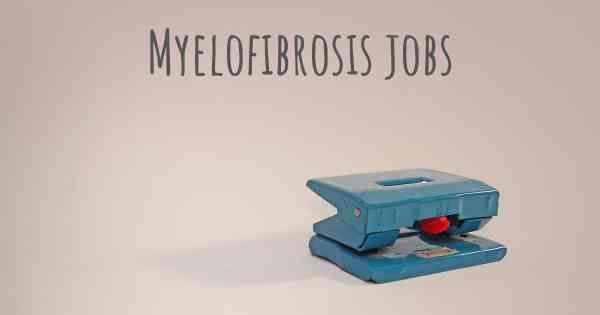Can people with Myelofibrosis work? What kind of work can they perform?
See how people with experience in Myelofibrosis give their opinion about whether people with Myelofibrosis can work and what kind of jobs are more appropriated for people with Myelofibrosis

Can people with Myelofibrosis work?
Myelofibrosis is a rare and chronic bone marrow disorder that affects the production of blood cells. It is characterized by the replacement of bone marrow with fibrous scar tissue, leading to various complications. The symptoms of myelofibrosis can vary from person to person, and the severity of the condition can also differ. Therefore, the ability to work with myelofibrosis depends on several factors, including the individual's overall health, symptoms, and treatment plan.
Impact of Myelofibrosis on Work
Myelofibrosis can cause a range of symptoms that may affect a person's ability to work. These symptoms can include fatigue, weakness, shortness of breath, pain, and an enlarged spleen. Additionally, individuals with myelofibrosis may experience frequent infections, anemia, and other complications related to the disorder.
1. Fatigue: Fatigue is a common symptom of myelofibrosis and can significantly impact a person's energy levels and ability to perform daily tasks, including work-related activities. It may require individuals to take frequent breaks or limit their working hours.
2. Physical limitations: Some individuals with myelofibrosis may experience physical limitations due to pain, weakness, or an enlarged spleen. These limitations can affect their ability to perform physically demanding tasks or jobs that require prolonged standing or heavy lifting.
3. Treatment side effects: Treatment for myelofibrosis, such as medications or bone marrow transplantation, can have side effects that may impact a person's ability to work. These side effects can include nausea, vomiting, hair loss, and increased susceptibility to infections.
Work Options for Individuals with Myelofibrosis
The ability to work with myelofibrosis varies from person to person, and it is essential to consider individual circumstances and limitations. However, many individuals with myelofibrosis can continue to work, either in their current job or by making certain accommodations. Here are some work options that may be suitable for individuals with myelofibrosis:
1. Flexible work arrangements: Flexible work arrangements, such as part-time work, telecommuting, or job sharing, can provide individuals with myelofibrosis the opportunity to manage their symptoms and work at their own pace. This flexibility allows for better management of fatigue and physical limitations.
2. Job modifications: In some cases, individuals with myelofibrosis may be able to modify their current job to accommodate their symptoms and limitations. This can include adjusting work hours, reducing physical demands, or providing assistive devices to aid in performing tasks.
3. Career change: Depending on the severity of symptoms and limitations, individuals with myelofibrosis may consider a career change to a less physically demanding or more flexible job. This can help accommodate their condition while still allowing them to remain in the workforce.
4. Self-employment: Starting a small business or working as a freelancer can provide individuals with myelofibrosis the flexibility to manage their symptoms and work according to their own schedule. This option allows for better control over workload and rest periods.
5. Vocational rehabilitation: Vocational rehabilitation programs can assist individuals with myelofibrosis in finding suitable employment options. These programs provide support, training, and resources to help individuals with chronic health conditions maintain or re-enter the workforce.
Supportive Measures for Working with Myelofibrosis
Working with myelofibrosis may require certain supportive measures to ensure the well-being and productivity of individuals. These measures can include:
1. Open communication: It is crucial for individuals with myelofibrosis to communicate openly with their employers, supervisors, and colleagues about their condition and any limitations they may have. This allows for understanding and potential accommodations.
2. Regular medical check-ups: Regular medical check-ups and consultations with healthcare professionals are essential for managing myelofibrosis. These appointments help monitor the condition, adjust treatment plans, and provide necessary documentation for workplace accommodations if required.
3. Work-life balance: Maintaining a healthy work-life balance is crucial for individuals with myelofibrosis. It is important to prioritize rest, manage stress levels, and engage in activities that promote overall well-being.
4. Support networks: Joining support groups or connecting with others who have myelofibrosis can provide emotional support, information, and practical advice for managing work-related challenges.
5. Reasonable accommodations: Employers are legally obligated to provide reasonable accommodations to individuals with disabilities, including those with myelofibrosis. These accommodations can include modified work schedules, ergonomic adjustments, or changes in job responsibilities to ensure equal opportunities and accessibility.
In conclusion, the ability to work with myelofibrosis depends on various factors, including the individual's overall health, symptoms, and treatment plan. While some individuals may need to make adjustments to their work arrangements or consider a career change, many can continue working with appropriate accommodations and support. It is important for individuals with myelofibrosis to consult with their healthcare team, communicate openly with their employers, and explore available resources to make informed decisions about their work options.








